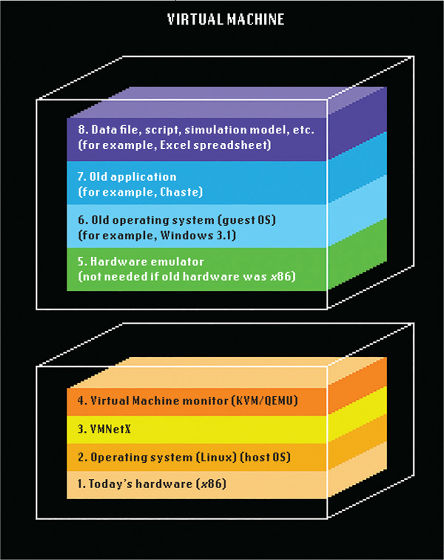What is the virtual system 'Olive' that can run all past machines & software and protect scientific reproducibility?

Researchers at Carnegie Mellon University are developing a system " Olive " that can reproduce past computer and software in virtual machines as "to protect science".
Carnegie Mellon is Saving Old Software from Oblivion - IEEE Spectrum
https://spectrum.ieee.org/computing/software/carnegie-mellon-is-saving-old-software-from-oblivion
The newly obtained scientific knowledge is guaranteed its truth by being verified by a third party. In general, after being reviewed, after being sent out to the world as a scientific thesis, it can be said that a lot of verifications are being done by being touched by the eyes of many scientists around the world. And verification of science and technology is required to be reproducible even after a long time passes.
In recent years, the use of computers has become indispensable for research on science and technology by being utilized not only for storing data but also for analyzing data and simulating data. Thanks to the advancement of computers, the development of science and technology is acceleratingly developing.
However, as computers progress too quickly, the speed with which hardware and software become obsolete is quick, and it is not rare that "old software can not run because there is no hardware." The fact that software can not be used over time leads to the situation that "technologies verifying the certainty of science and technology can not be used later" at that time.

In order to solve this problem, Professor Mahadev Sachi Anai Raiann who studies computer science at Carnegie Mellon University, et al. Reported that software that was running on any computer OS named "Open Library of Images for Virtualized Execution (Olive)" We are developing a virtual machine system that can reproduce. In the Olive project, there is a grand goal of "providing all software experiences running on computers such as applications and OS on the Internet".
In order to reproduce the old computing environment, Olive said that the system is designed by deliberately deeply abstracting the software and multilayered it. At the lowest level, as a common foundation of today's computer technology, one or more x86 microprocessors are placed, and the Linux OS is running on it. Dedicated software called "Virtual Machine Network Execution. (VMNetX)" is placed on the OS to execute the virtual machine network. VMNetX has the advantage that it can be used remotely from the central server, if necessary, so that you can use it without downloading the entire virtual machine or memory data on your computer.
There is a hardware emulator in the next layer of VMNetX, there is an OS that activates old software stored in the next layer, there is a layer of software on top of it, and there is a layer that finally sends necessary data to software , Has become a layer structure called.

Olive said that it consists of 17 kinds of virtual machines at the time of article creation. One of them, running "Mosaic" for Apple's Macintosh System 7.5 using Motorola 68040 CPU emulation seems to work quite comfortably because of the high performance of modern computers, even in a virtualized environment.

Olive has some challenges, one of which is "GPU emulation". In science and technology for many years, we have increased the computing speed by utilizing GPU with high parallel computing performance, but in the future we need to develop GPU emulation in order to archive software utilizing this GPU .
At the moment it is only project members that they can access old software collections installed on Olive due to software license restrictions. In the future, it is required to create a mechanism that allows many users to use software on Olive by installing cooperation of affiliated companies etc. of software to be archived. Professor Ana Raiannan thinks that "Olive will be a good starting point for creating a system that ensures that past software can be used in the future."

Related Posts:







